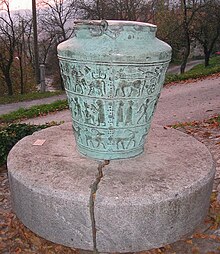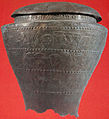
Adria is a town and comune in the province of Rovigo in the Veneto region of northern Italy, situated between the mouths of the rivers Adige and Po. The remains of the Etruscan city of Atria or Hatria are to be found below the modern city, three to four metres below the current level. Adria and Spina were the Etruscan ports and depots for Felsina. Adria may have given its name during an early period to the Adriatic Sea, to which it was connected by channels.

The Veneti were an Indo-European people who inhabited northeastern Italy, in an area corresponding to the modern-day region of Veneto, from the middle of the 2nd millennium BC and developing their own original civilization along the 1st millennium BC.

Cisalpine Gaul was the name given, especially during the 4th and 3rd centuries BC, to a region of land inhabited by Celts (Gauls), corresponding to what is now most of northern Italy.

The Hallstatt culture was the predominant Western and Central European archaeological culture of the Late Bronze Age from the 12th to 8th centuries BC and Early Iron Age Europe from the 8th to 6th centuries BC, developing out of the Urnfield culture of the 12th century BC and followed in much of its area by the La Tène culture. It is commonly associated with Proto-Celtic speaking populations.

Venetic is an extinct Indo-European language, usually classified into the Italic subgroup, that was spoken by the Veneti people in ancient times in northeast Italy and part of modern Slovenia, between the Po Delta and the southern fringe of the Alps, associated with the Este culture.
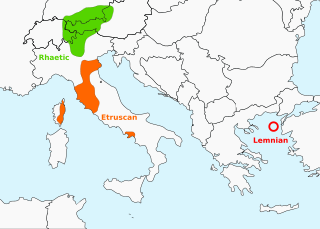
Rhaetic or Raetic, also known as Rhaetian, was a Tyrsenian language spoken in the ancient region of Rhaetia in the eastern Alps in pre-Roman and Roman times. It is documented by around 280 texts dated from the 5th up until the 1st century BC, which were found through northern Italy, southern Germany, eastern Switzerland, Slovenia and western Austria, in two variants of the Old Italic scripts. Rhaetic is largely accepted as being closely related to Etruscan.
Mauro Cristofani was a linguist and researcher in Etruscan studies.
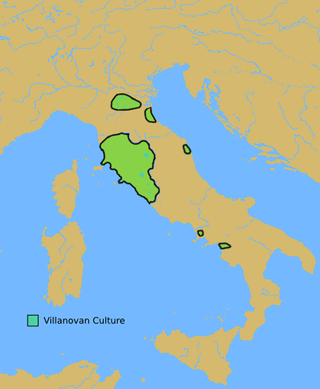
The Villanovan culture, regarded as the earliest phase of the Etruscan civilization, was the earliest Iron Age culture of Italy. It directly followed the Bronze Age Proto-Villanovan culture which branched off from the Urnfield culture of Central Europe. The name derives from the locality of Villanova, a fraction of the municipality of Castenaso in the Metropolitan City of Bologna where, between 1853 and 1855, Giovanni Gozzadini found the remains of a necropolis, bringing to light 193 tombs, of which there were 179 cremations and 14 inhumations.

The Italic peoples were an ethnolinguistic group identified by their use of Italic languages, a branch of the Indo-European language family.

Terramare, terramara, or terremare is a technology complex mainly of the central Po valley, in Emilia, Northern Italy, dating to the Middle and Late Bronze Age c. 1700–1150 BC. It takes its name from the "black earth" residue of settlement mounds. Terramare is from terra marna, "marl-earth", where marl is a lacustrine deposit. It may be any color but in agricultural lands it is most typically black, giving rise to the "black earth" identification of it. The population of the terramare sites is called the terramaricoli. The sites were excavated exhaustively in 1860–1910.

Situla, from the Latin word for bucket or pail, is the term in archaeology and art history for a variety of elaborate bucket-shaped vessels from the Bronze Age to the Middle Ages, usually with a handle at the top. All types may be highly decorated, most characteristically with reliefs in bands or friezes running round the vessel.

The Golasecca culture was a Late Bronze Age/Early Iron Age culture in northern Italy, whose type-site was excavated at Golasecca in the province of Varese, Lombardy, where, in the area of Monsorino at the beginning of the 19th century, Abbot Giovanni Battista Giani made the first findings of about fifty graves with pottery and metal objects.
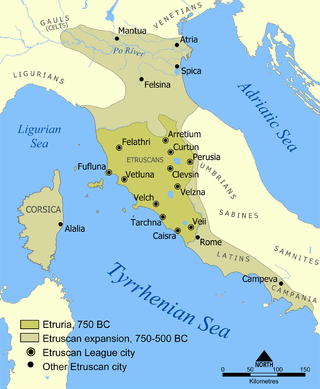
Etruscan history is the written record of Etruscan civilization compiled mainly by Greek and Roman authors. Apart from their inscriptions, from which information mainly of a sociological character can be extracted, the Etruscans left no surviving history of their own, nor is there any mention in the Roman authors that any was ever written. Remnants of Etruscan writings are almost exclusively concerned with religion.

The prehistory of Italy began in the Paleolithic period, when species of Homo colonized the Italian territory for the first time, and ended in the Iron Age, when the first written records appeared in Italy.

A Daunian stele is a type of stone funerary monument constructed by the Daunians, an Iapygian tribe which inhabited Apulia in classical antiquity. Daunian stelae were made from the end of the 8th century BC to the 6th century BC. They consist of a parallelepiped-shaped plate with a protrusion on the upper side and decoration on all four sides. Sizes vary between 40 and 130 cm in height, and consequently, between 20 and 80 cm in width while the thickness is between 3 and 12 cm.
The Proto-Villanovan culture was a late Bronze Age culture that appeared in Italy in the first half of the 12th century BC and lasted until the 10th century BC, part of the central European Urnfield culture system.
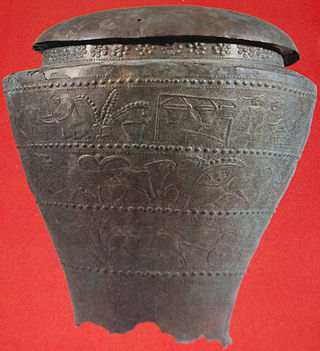
The Benvenuti Situla is a bronze situla that dates to ca. 600 B.C. It is a product of the situla art that spread north from the Etruscans in this period, in this case to the Este culture that flourished in Este, Veneto during the 7th century BC. The vessel is now conserved in the local National Museum Atestino. The relief work on the vessel depicts scenes of aristocratic life. These include banqueting as well as scenes of military victory. The iconography of the relief scenes of the situla may indicate Etruscan influence.
Maria Bonghi Jovino is an Italian archaeologist. Bonghi Jovino was Professor of Etruscology and Italic Archaeology at the University of Milan.
Guglielmo Maetzke was an Italian archaeologist and etruscologist. A pupil of the Etruscologist Massimo Pallottino, he directed important excavation campaigns in Tuscany, Lazio, Campania and Sardinia.

